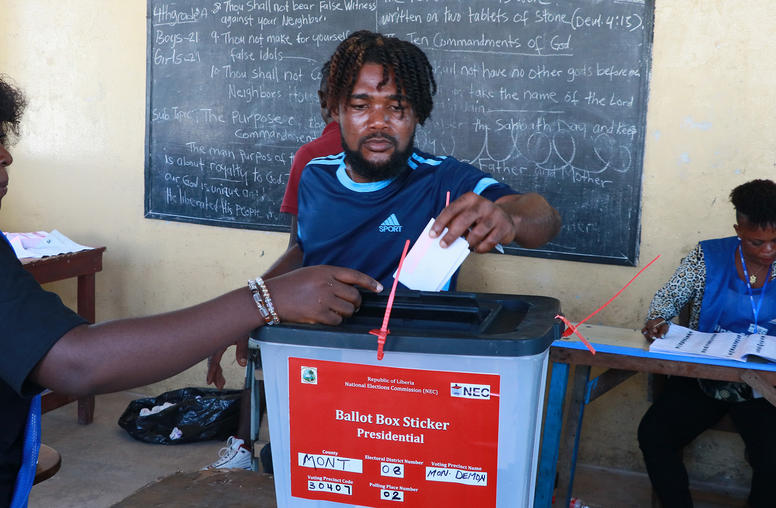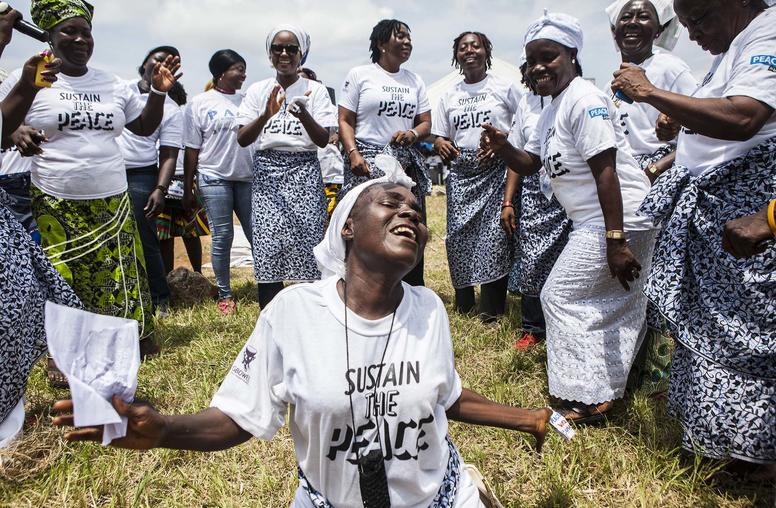Liberian President Optimistic on Country’s Outlook
If there is a Cinderella story in sub-Saharan Africa, President Ellen Johnson Sirleaf would argue it belongs to Liberia. Years of civil war, economic mismanagement and staggering debt all conspired to bring an already-ravaged economy to its knees by 2005. Read how President Sirleaf worked to turn the country around.
June 28, 2011
If there is a Cinderella story in sub-Saharan Africa, President Ellen Johnson Sirleaf would argue it belongs to Liberia.
Years of civil war, economic mismanagement and staggering debt all conspired to bring an already-ravaged economy to its knees by 2005. Average income had plummeted, debt had ballooned and the evils of Liberia’s tyrannical past - and the civil wars it caused – had claimed the lives of as many as 250,000 people. Another 500,000 Liberians were displaced by those wars, causing among other things a brain drain: doctors alone had fled at such a rate that by 2003, there were just 50 in a country that is now more than three million. And yet as alarming as all that was, the sterile metrics of a country in despair don’t capture the intangible effects, like a generation’s loss of its own dignity.
“Families were shattered, communities uprooted, governance systems destroyed,” President Sirleaf said during remarks at USIP June 24. “Commercial and productive activities collapsed, infrastructure devastated – our human infrastructure was in ruins.”
What a difference a few years can make. From peace and security to economic revitalization, Liberia is on its way to earning the title of one of the world’s most successful Comeback Kids.
Today Sirleaf can boast a national budget of about $370 million, up from $80 million some years earlier. Its gross domestic product has risen to an annual average of 6.5 percent, and the country’s previous inflation rate of 20 percent is now in the single digits, she said. And with no apology for her pride, Sirleaf proclaimed that the bulk of the $4.9 billion in debt under which the country was withering has been retired. Those kinds of trends show how far the country has come, but also animate Sirleaf’s conviction that the country can achieve some form of economic sustainability within 10 years.
“Liberia has risen from the ashes of war and destruction to become an emergent democratic nation with the potential to lift itself out of a dire situation in what has really been a volatile situation,” she said. And the rate of its economic growth is the envy of other African nations if not the United States itself, as USIP board member Chet Crocker said only half-jokingly in his own introductory remarks.
Sirleaf is now laying out ambitious goals for what she says is a two-decade effort at improving peace and security, the economy, the country’s infrastructure and its governance and rule of law. She predicts with confidence that Liberia will not ask for foreign assistance in 10 years. “I go further to say that as we develop our long-term perspective in our development agenda, that Liberia is determined to join the ranks of middle-income countries by the year 2030,” she said.
It’s that kind of optimism that contributes to the perception others have that the story of Liberia will be one of the true success stories of the continent.
“The 21st Century is young, but I believe when the history of the century is written, that the story of Liberia will go down as a very fine moment in Africa’s modern history,” said USIP’s Crocker.
But given Sirleaf’s bullish outlook, the question quickly becomes: just how realistic is her ambitious agenda? Experts wonder aloud if her predictions will be derailed by deep-seated poverty and income inequality, weak human capital due to the war and endemic corruption. Poor security and a lack of stability across the region contribute to temper Sirleaf’s optimism.
“These are hurdles Liberia needs to overcome to make the progress she envisages,” says USIP’s Raymond Gilpin.
Yet Sirleaf adamantly believes the country is marching forward. Much of Liberia’s turnaround can be attributed to American assistance, including a $200 million contribution from the U.S. in 2003 to pay for a United Nations force – and sustained support from the Congress since. Indeed, in her two days of visits to the U.S. capital, Sirleaf was told the U.S. would continue its appropriation to Liberia’s “crawling economy,” as AllAfrica.com put it.
Aid from other countries, the World Bank and the International Monetary Fund have all helped to bring a country back from the brink. But private investment has made a significant impact, helping also to create the perception that Liberia is crafting a new narrative of itself. Delta Airlines, for example, has increased the number of flights into Robertsfield from one to three. Chevron will begin offshore drilling by the end of the year, and Firestone Natural Rubber, which has operated inside Liberia for about 80 years, is making new investments in the country. Firestone has over the years been accused of gross violations of labor laws, including child labor abuses. But Sirleaf said the firm is improving its treatment of workers. But jobs tops the agenda.
“All of these will remain empty facts and statistics if they collectively do not create the jobs for the Liberian people,” Sirleaf said. “Unemployment remains our biggest challenges, and a priority for our government.” The blueprint for turning a staggering unemployment rate of 85 percent lies in finding labor-intensive industries, Sirleaf says, and develop more small business with vocational training and a “sustained and renewed effort to raise educational standards for all of our citizens.”
Much of the unemployed are former child soldiers who never had the opportunity to go to school.
Corruption reform is another key aspect of the country’s focus, and Liberia moved up 41 places on Transparency International’s Global Corruption Index. And more recently, it moved from 97 to 87 on the index, out of a total of 178 – the last slot occupied by Somalia.

